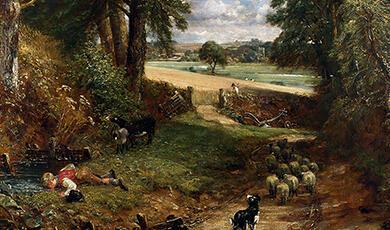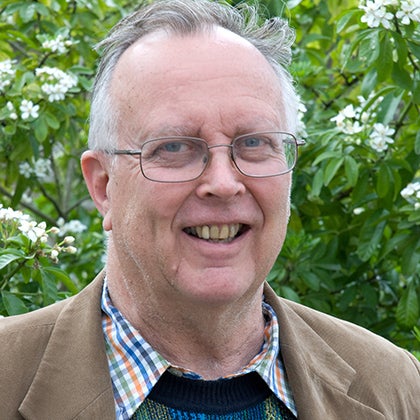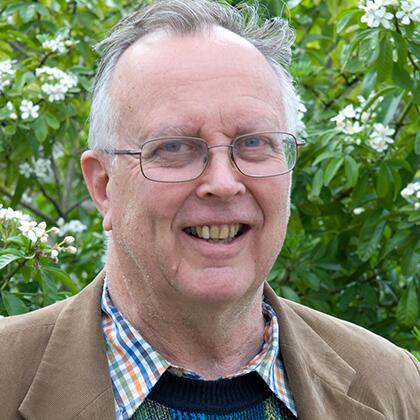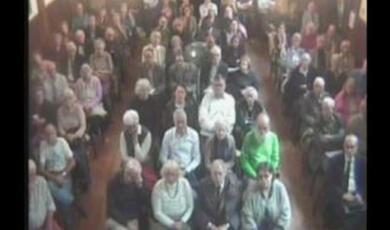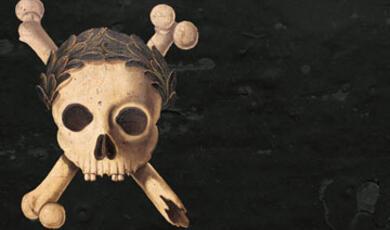Who invented the calculus? - and other 17th century topics
Share
- Details
- Text
- Audio
- Downloads
- Extra Reading
The development of the calculus brought together two seemingly unrelated problems: how do things change, and how large are they? We develop the story from the early days of logarithms in Gresham College, to Newton's work on gravitation and the calculus, and ask: Did the apple really fall on Newton's head?
Download Text
WHO INVENTED THE CALCULUS?
Professor Robin Wilson
Introduction
We’ve now covered two-thirds of our journey ‘From Caliphs to Cambridge’, and in this lecture I want to try to survey the mathematical achievements of the seventeenth century – a monumental task.
I’ve divided my talk into four parts – first, the movement towards the practical sciences, as exemplified by the founding of Gresham College and the Royal Society. Next, we’ll gravitate towards astronomy, from Copernicus to Newton. Thirdly, we visit France and the gradual movement from geometry to algebra (with a brief excursion into some new approaches to pi) – and finally, the development of the calculus.
So first, let’s make an excursion to Gresham College.
Practical science
The Gresham professorships arose from the will of Sir Thomas Gresham, which provided for £50 per year for each of seven professors to read lectures in Divinity, Astronomy, Music, Geometry, Law, Physic and Rhetoric. As the Ballad of Gresham College later described it:
If to be rich and to be learn’d
Be every Nation’s cheifest glory,
How much are English men concern’d,
Gresham to celebrate thy story
Who built th’Exchange t’enrich the Citty
And a Colledge founded for the witty.
From its beginning, Gresham College encouraged the practical sciences, rather than the Aristotelian studies still pursued at the ancient universities:
Thy Colledg, Gresham, shall hereafter
Be the whole world’s Universitie,
Oxford and Cambridge are our laughter;
Their learning is but Pedantry.
These new Collegiates doe assure us
Aristotle’s an Asse to Epicurus.
The lectures were presented at Sir Thomas’s house in Bishopsgate Street , which became known as Gresham College. In particular, the geometry and astronomy lectures were read twice each week, in Latin (for scholars) and English (for mariners and any others interested):
The geometrician is to read as followeth, every Trinity term arithmetique, in Michaelmas and Hilary terms theoretical geometry, in Easter term practical geometry. The astronomy reader is to read in his solemn lectures, first the principles of the sphere, and the theory of the planets, and the use of the astrolabe and the staff, and other common instruments for the capacity of mariners.
The first Gresham Professor of Geometry, in early 1597, was Henry Briggs, who invented the method of long division that we all learnt at school. At Gresham College he worked on navigation, on tables for finding the height of the pole star, and on eclipses.
In 1614 the Scottish laird John Napier introduced logarithms, designed to replace lengthy computations involving multiplication and division by easier ones with addition and subtraction. At Gresham College , Henry Briggs was enthusiastic about the
new and remarkable logarithms. I never saw a Book which pleased me better or made me more wonder.
Unfortunately, Napier’s logarithms were cumbersome – in particular, log 1 didn’t equal 0. As Briggs wrote:
I myself, when expounding this doctrine publicly in London to my auditors in Gresham College , remarked that it would be much more convenient that 0 should be kept for the logarithm of the whole sine.
Briggs visited Napier in Edinburgh to discuss such matters and, on returning to Gresham College , devised a new form of logarithm, his ‘logs to base 10’, in which to multiply two numbers we simply add their logarithms. In his Arithmetica logarithmica of 1624 he published his extensive hand-calculations of the logarithms of 30,000 numbers to 14 decimal places, and these proved to be of enormous value to mariners and navigators.
Their invention quickly led to the development of instruments based on a logarithmic scale. Most notable was the slide rule, versions of which first appeared around 1630 and were widely used for over three hundred years until the advent of the pocket calculator.
By that time Briggs was no longer at Gresham College. In 1619 Sir Henry Savile, Warden of Merton College in Oxford , founded professorships there in geometry and astronomy, finding ‘the mathematical studies to be neglected by the generality of men’. Savile had himself lectured on Euclid’s Elements and on the new astronomy of Copernicus. Here’s his memorial in the ante-chapel at Merton, showing Euclid and Ptolemy.
Briggs was offered the Oxford geometry Chair, which he held until his death in 1631. Another candidate was Edmund Gunter of Christ Church. Savile sent for Gunter who came
and brought with him his sector and quadrant and fell to resolving of triangles and doing a great many fine things. Said the grave knight, ‘Doe you call this reading of Geometrie? This is showing of tricks, man!’, and so dismissed him with scorn, and sent for Henry Briggs.
Instead, Gunter was appointed Gresham Professor of Astronomy, becoming famous for his measuring instruments, such as the ‘Gunter quadrant’ and ‘the Gunter sector’; he invented the logarithmic scale later used in the slide rule, and was the first person to use the word ‘cosine’.
It was around this time that other calculating devices were introduced. In Germany , Schickhard designed a calculating machine, and later ones were constructed by Pascal and Leibniz for the purpose of carrying out simple arithmetical calculations.
After the Civil War, the mathematical scene moved to Oxford , to Wadham College , where an informal group of highly talented individuals gathered under the Wardenship of John Wilkins. Wilkins’ group, with up to thirty members, met weekly in his lodgings and at the new coffee houses in High Street, and became the centre of Oxford’s experimental philosophy school in the 1650s.
This group rejected the scientific theories of Aristotelian physics, studied in the universities, in favour of the recent experimental views of Francis Bacon and others. Here, advances in science were based on a blend of scientific experiment and theorising, in which hypotheses were tested by taking measurements and refined accordingly. Bacon’s Great Instaurationof 1620 had shown a ship sailing into the great unknown beyond, with the slogan ‘Many shall pass through and knowledge will increase’.
Bacon was not himself a great experimenter: in his most famous experiment, on refrigeration, he stuffed a chicken full of snow; sadly, the result of this experiment was that he caught pneumonia and died.
The Royalist professors in Oxford were replaced by those more sympathetic to the Parliamentarian cause. The Savilian Geometry Chair went to John Wallis, who had deciphered secret codes for Cromwell during the Civil War. Wallis’s enthusiasm for mathematics came from reading Oughtred’s Clavis mathematicae, an algebra text later used at Gresham College. However, he had little mathematical experience and enjoyed no public recognition as a mathematician. As he remarked:
In the year 1649 I removed to Oxford , being then Publick Professor of Geometry, of the Foundation of Sir Henry Savile. And Mathematicks which before had been a pleasing diversion, was now to be my serious Study.
A mathematics appointment on flimsier evidence is hard to imagine, and yet Wallis established Oxford as the centre for mathematical activity while he himself became the most influential English mathematician before the rise of Newton , holding the Savilian Chair for over fifty years.
In the 1650s, Wallis wrote several much-admired works. One concerned the geometrical properties of the conic sections – the parabola, ellipse and hyperbola of Greek times; this book contained the first appearance of the symbol for infinity. Another was his Arithmetica infinitorum, which introduced the mathematical term ‘interpolation’ and contained his product formula for π, which we’ll see later.
Other members of the experimental philosophy school included Robert Boyle and his collaborator Robert Hooke. Hooke was a remarkable person, best known for his work with Boyle on the air pump, leading to the gas-pressure law now known as ‘Boyle’s law’; for his invention of the microscope, described in his Micrographia of 1665; and for ‘Hooke’s law’ on the extension of springs. He was once described as:
the greatest experimenter who ever lived – like Leonardo da Vinci, but better organised!
Another important member of the Wadham group was Christopher Wren, who came to the College as an undergraduate and quickly impressed everyone with his brilliance. Later described by Isaac Newton as one of the three leading geometers of his age, he was appointed Gresham Professor of Astronomy in 1657. In his inaugural address at Gresham College , Wren praised Henry Briggs, describing the useful invention of logarithms as
wholly a British art which at Gresham College received great additions.
So far I haven’t mentioned the Royal Society, whose early history is intimately connected with Gresham College. It was after attending a Gresham lecture, given by Christopher Wren in 1660, that the Oxford group proposed the new society which, like Gresham College , was to popularise experimental science. It met in Gresham College , and King Charles II gave the Society its Royal Charter in 1662.
The Royal Society’s Curator of Experiments was Robert Hooke, who became Gresham Professor of Geometry for thirty-seven years, and who made the College an important centre for scientific research and debate. In 1674 the Gresham authorities gave him £40 to erect a turret to make astronomical observations.
The next year, in 1675, Charles II founded the Royal Observatory at Greenwich , containing the famous Octagon Room that housed many of the best astronomical instruments of the day – which leads us to …
Gravitation
Until the 16th century, the motion of the planets was described by Ptolemy’s earth-centred system, with the sun and the planets orbiting the earth. In 1543, this was replaced by a revolutionary new idea (in every sense) – a heliocentric system in which the sun lies at the centre and the earth is just one of several planets travelling in circular orbits around it.
This new theory was due to Nicolaus Copernicus, the ‘father of modern astronomy’, who was born in Poland. Although it had been suggested previously by others, Copernicus was the first to develop the underlying theory and work out its consequences in full mathematical detail. His bookDe revolutionibus orbium coelestium [On the revolution of the heavenly spheres] was published in 1543 and a copy of it was presented to him on his death-bed.
Copernicus showed that the six planets then known split into two groups: Mercury and Venus, whose orbits lie inside that of Earth; and Mars, Jupiter and Saturn, with orbits outside it. He listed these planets in increasing order of distance from the sun, thereby illuminating phenomena that the Ptolemaic system had failed to explain, such as why Mercury and Venus are visible only at dawn and dusk while the other planets are visible throughout the night.
The Copernican solar system aroused much controversy and brought its supporters into conflict with the Church who considered the earth to lie at the centre of Creation, so that Copernicus’ ideas were at variance with the Holy Scriptures. The philosopher Giordano Bruno was burned alive for heresy for espousing the Copernican theory.
Even the great Galileo Galilei got into serious trouble. Galileo taught mathematics in Padua , and was the first astronomer to make extensive use of the telescope, discovering sunspots and the moons of Jupiter and Saturn, and drawing the moon’s surface. In his mechanics book Two new sciences (1638) he discussed the laws of uniform and accelerated motion and explained why the path of a projectile must be a parabola. Earlier, in 1632, he had published his Dialogue concerning the two chief world systems, describing the advantages of the Copernican system over Ptolemy’s. At his famous Inquisition trial in 1633, he was forced to recant. Galileo died in 1642, the year of Newton’s birth, and was not pardoned by the Church until 1995.
Earlier, the Danish astronomer Tycho Brahe had been the greatest pre-telescope observer of the heavens. In 1572 he discovered a new star, or ‘nova’, in the constellation of Cassiopeia, and five years later his observations of a comet proved that the solid celestial spheres on which the planets were supposed to move did not exist. In the 1570s he built the magnificent observatory of Uraniborg on the island of Hven , where he constructed astronomical instruments of unsurpassed accuracy and measured and catalogued over seven hundred stars.
Tycho’s accurate and extensive observational records proved invaluable for his assistant Johannes Kepler. Kepler is remembered for the three laws of planetary motion that appeared in his New astronomy (1609) andThe harmony of the world (1619). Tycho’s data had led him to consider non-circular orbits, and Kepler proposed the laws that we now state as:
1: the planets move in elliptical orbits with the sun at one focus;
2: the line from the sun to a planet sweeps out equal areas in equal times;
3: the square of a planet’s period is proportional to the cube of its orbit’s mean radius.
These laws were based on observed results; it was to be Newton , some eighty years later in the Principia, who explained why they were true.
Kepler was indeed fascinated by ellipses and other conics, and introduced the word ‘focus’ into mathematics. He was also interested in polyhedra and his name is associated with the ‘Kepler-Poinsot star polyhedra’. Less successfully, he claimed that the five regular solids fit snugly between the orbits of the six known planets: a cube between Saturn and Jupiter, a tetrahedron between Jupiter and Mars, and so on.
An alternative theory of the universe was provided by René Descartes, who proposed that the stars and planets moved around in whirlpools, called ‘vortices’; this theory was later demolished by Isaac Newton.
The story of the apple, which Newton recounted in his old age, has become part of scientific folk-lore. Seeing an apple fall, he hypothesised that the gravitational force that pulls the apple to earth is the same as the force – a universal force – that keeps the moon orbiting around the earth and the earth orbiting around the sun. Moreover, this planetary motion is governed by a universal law of gravitation, the ‘inverse-square law’: the force of attraction between two objects varies as the product of their masses and inversely as the square of the distance between them; thus, if the distance is multiplied by 10, the force decreases by a factor of 100.
Newton formulated these discoveries during the plague years of 1665-7, but it was not until twenty years later that they were expounded. In hisPrincipia mathematica (1687), possibly the greatest scientific work of all time, Newton used the inverse-square law to explain Kepler’s laws of elliptical motion and account for cometary orbits, the variation of tides, and the flattening of the earth at the north and south poles due to the earth’s rotation.
No person ever reached higher than Isaac Newton. As Laplace said, many years later,
there is only one universe, and it could thus be given to only one person to discover its fundamental law, the universal law of gravitation
– and Edmond Halley wrote in his ‘Ode prefixed to the Principia’:
Come celebrate with me in song the name
Of Newton , to the Muses dear; for he
Unlocked the hidden treasuries of Truth:
So richly through his mind had Phoebus cast
The radiance of his own divinity.
Nearer the gods no mortal may approach.
How did the Principia get written? In 1684 Halley was talking with Robert Hooke and Christopher Wren at the Royal Society about whether an inverse-square law of force between the sun and a planet must necessarily produce an elliptical orbit. To clarify his thoughts he repaired to Cambridge to see Isaac Newton, and asked him directly what the orbit would be:
Sir Isaac replied immediately that it would be an ellipsis; the Doctor struck with joy and amazement asked him how he knew it. Why, said he, I have calculated it, whereupon Dr Halley asked him for his calculation without any further delay. Sir Isaac looked among his papers but could not find it, but he promised him to renew it, and then to send it to him.
Newton set to work and produced De Motu Corporum in Gyrum (On the motion of bodies in an orbit) in late 1684. This he expanded over the next two years, with much encouragement, cajoling and flattering by Halley, eventually producing the Principia in 1687. But it nearly didn’t appear. The Royal Society, who should have paid for the publication, ran out of money after producing a very expensive History of Fishes, and so Halley himself paid for the entire publication. His only recompense from the Royal Society was fifty free copies of the History of Fishes.
What does the Principia contain? After Newton’s laws of motion, the main part of the Principia consists of three books, of which the third The System of the World, is the climax. Newton recommends that the reader proceed directly to this third book, referring back whenever necessary. But we’ll go through them in order.
In Book I, Newton explained Kepler’s laws of planetary motion. Assuming the existence of an inverse-square law of gravity, Newton proved Kepler’s law, that the planets orbit in ellipses – and also obtained a converse result, that if a planet under a central law of gravitation travels in an elliptical orbit, then the law of gravity must be an inverse-square one. Newton’s proof of Kepler’s second law appeared in Proposition 1 of Book I, and Newton also proved Kepler’s third law, under the assumption of an inverse-square law.
Book II is concerned with the movement of objects in resisting media – such as a ball bearing in treacle. Here, Newton demolished Descartes’ rival theory of the universe, that the planets move around the heavens in mini-vortices, or whirlpools.
In Book III, Newton obtained a number of amazing results. These include the calculation of the speed that a projectile needs to travel in order to escape from the earth’s atmosphere; results on the precession of the equinoxes; the motion of comets; and the shape of the earth as it rotates. This last one proved to be decisive. Under Newton’s hypotheses, the rotation of the earth causes a flattening at the poles so that the earth is onion-shaped, whereas under Descartes’ vortex theory the rotation of the earth causes an elongation at the poles so that the earth is lemon-shaped. It was not until the late-1730s that Newton’s prediction was found to be correct.
Newton’s Principia made him famous – few people read it, and even fewer understood it, but everyone knew that it was a great work, rather like Einstein’s theory of relativity over two hundred years later. As Voltaire, a great enthusiast for Newton , remarked:
Newton has very few readers, because it requires great knowledge and sense to understand him. Everybody however talks about him.
Talking of Voltaire, leads us to our third topic, French mathematics.
French mathematics
In France , there were exciting developments in mathematics, in a wide variety of directions.
In algebra, François Viète pioneered an improvement in notation, using letters for unknowns, rather than writing them in words. He insisted on the importance of dimension, disallowing earlier problems that involved ‘adding lines to areas’ (meaning ax 2 + bx). This use of letters was later extended by Descartes, who wrote powers in the modern way (x 3, x 4, etc.), although he preferred xx to x 2.
Viète was also interested in the calculation of pi. By considering polygons with 393,216 sides, he found ¹ to nine decimal places, and he also produced the first exact formula, involving many square roots. Another expression for pi was later given by Wallis, who obtained the remarkable equation
pi = 2 × 2 × 4 × 4 × 6 × 6 × 8 × …
1 × 3 × 3 × 5 × 5 × 7 × 7 × …
In the 1670s, Gregory and Leibniz produced a very simple series, related to the arctangent function:
pi/4 = 1 – 1/ 3 + 1/ 5 – 1/ 7 +
Unlike 16th-century Italy , where secrecy about one’s results was all-important, French achievements were widely circulated. Marin Mersenne, a minimite friar who was fascinated with mathematics and contributed to several areas of the subject (being remembered for ‘Mersenne primes’ of the form 2 k – 1). Mersenne corresponded with many mathematicians, such as Fermat, Pascal and Roberval, thereby helping to make their results better known. We now look at these three correspondents in turn.
Pierre de Fermat made spectacular advances in number theory and analytic geometry, although he did not publish his results. In number theory he is particularly remembered for his ‘little theorem’, that for any integer a and prime number p, a p – a is always divisible by p: for example, 14 37 – 14 is divisible by 37. He is also remembered for his famous claim to have proved what is now known as ‘Fermat’s last theorem’:
for any value of n > 2, there are no positive integers x, y and z that satisfy the equation x n + y n = z n.
Fermat proved this result in the special case n = 4, but a full proof had to wait until 1995, when it was obtained by Andrew Wiles.
Gilles Personne de Roberval solved a famous problem involving a popular curve of the time – the cycloid: this is the curve traced out by a spot of mud on a bicycle tyre as the bicycle is wheeled along, and takes the shape of an arch. The problem was to find the area under one arch, and Roberval found it to be three times the area of the rolling circle. His solution was highly ingenious, and involved relating the area under the cycloid to that under another curve whose area could easily be calculated.
Blaise Pascal had a wide range of mathematical interests. At the age of 16 he stated his ‘hexagon theorem’ about six points on a conic joined up in a certain way. As mentioned earlier, he built a machine that could add and subtract numbers. He also wrote on atmospheric pressure (Pascal’s principle’), gave the first systematic treatment of binomial coefficients, containing ‘Pascal’s triangle’, and investigated the theory of probability.
One person who did not wish to become involved with Mersenne’s group was René Descartes, to whom we now turn.
A major development in algebra occurred in 1637, when Descartes wrote his celebrated Discourse on the method. This was a philosophical treatise on universal science that included a 100-page appendix on geometry, containing his fundamental contributions to analytic geometry.
One of the problems tackled by Descartes in the Discourse was an ancient geometrical problem of Pappus (c. 300 AD), which asked for the path traced out by a point that moved in a specified way relative to a given number of fixed lines. The statement of the problem is complicated, but Descartes’ approach was revolutionary – he named two particular lengths arising in the problem x and y and then calculated all the other lengths in terms of them, producing a quadratic equation – this showed that the desired path was a conic (parabola, ellipse or hyperbola).
Although Descartes did not define the rectangular (x,y)-Cartesian coordinates that are named after him, his use of algebraic methods to solve a geometrical problem set in train a gradual movement from geometry to algebra that continued for about one hundred years, culminating in the work of Euler.
Who invented the calculus?
During the 17th century, much progress was made on the two branches of the infinitesimal calculus, the seemingly unrelated areas now calleddifferentiation and integration.
Differentiation is concerned with how things change, or move, and at that time involved the solution of ‘tangent problems’, in which one desired to find the tangent to a given curve. One approach was to take to points on the curve and let them move close to each other. Another approach was to draw a circle that touched the curve at the point and draw its diameter – the required genet is then the line perpendicular to this diameter.
Integration, or ‘quadrature’, was the problem of finding the area under a given curve. This had been solved in several special cases – for example, Archimedes found the area inside a circle – and a number of techniques had been developed.
During the 17th century, through the work of Torricelli (a student of Galileo and the inventor of the barometer), Isaac Barrow (at one time Gresham Professor of Geometry), and others, it was gradually realised that these two branches of the calculus were actually inverses of each other – if you ‘integrate’ and then ‘differentiate’, you get back to where you started. It was Newton and Leibniz who first explained why this was the case.
Newton’s calculus was involved with movement – how things change with time, or ‘flow’. The tangent problems he was concerned with involved velocities, and in his Treatise on fluxions (circulated to his friends, but not published until after his death) he gave rules for calculating these velocities. For area problems he did not use a direct approach, but regarded them as inverse problems.
Leibniz’s calculus was very different. He had no concept of motion, but found his tangents by considering sequences of points lying close to each other on the curve and taking differences of ‘successive values’; these differences led to our current use of the letter d in the differential calculus. For area problems he drew vertical lines of infinitesimally small width and added up their areas, using an elongated S, written Ç , to denote the sum. We now call this an integral sign, and it was introduced by Leibniz in the autumn of 1675, within three weeks of his introducing thed notation for differentiation.
Many years later there arose a bitter priority dispute over the origins of the calculus. It is now generally accepted that Newton had the priority of discovery, while Leibniz was the first to publish his results. Moreover, Leibniz’s notations proved to be greatly superior to Newton’s and are still what we use today.
©Professor Robin Wilson , Gresham College , 16 November 2005
This event was on Wed, 16 Nov 2005
Support Gresham
Gresham College has offered an outstanding education to the public free of charge for over 400 years. Today, Gresham College plays an important role in fostering a love of learning and a greater understanding of ourselves and the world around us. Your donation will help to widen our reach and to broaden our audience, allowing more people to benefit from a high-quality education from some of the brightest minds.


 Login
Login

